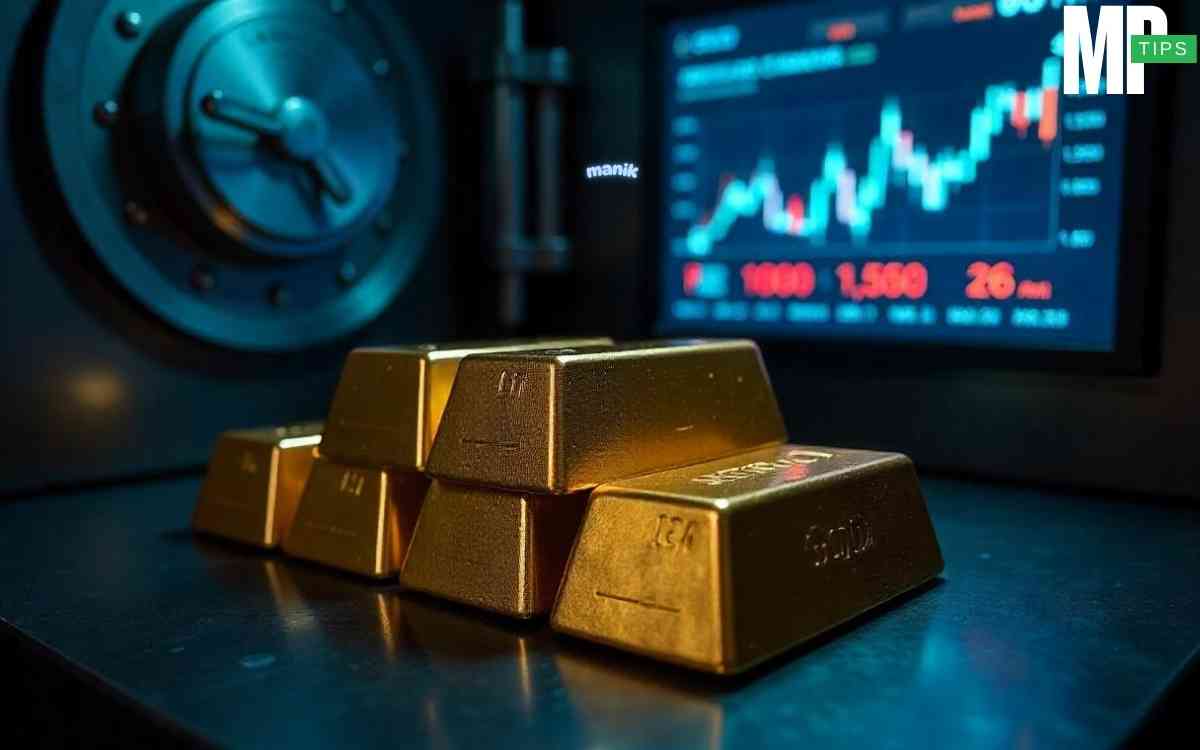Gold ETF or Physical Gold: Which One Makes You More Money?
Investing in gold has long been considered a safe haven, a hedge against inflation, and a store of value.
But with modern investment tools evolving, investors are left with a dilemma: should you put your money into traditional physical gold, or opt for a digital route with Gold ETFs (Exchange Traded Funds)?
The answer isn’t as straightforward as you might think. It hinges on several factors—costs, convenience, liquidity, and ultimately, the potential for returns.
In this detailed guide, we’ll explore every angle to help you make an informed decision about which gold investment could make you more money.

Contents
Key Takeaways
Additional Insights
Gold as an Investment
Gold is one of the oldest forms of currency and wealth preservation. It’s deeply embedded in cultures, economies, and portfolios around the world.
Whether it’s stashed in a family safe or traded on the stock exchange, gold continues to be a popular asset class.
Historical Significance of Gold
From ancient civilizations to modern economies, gold has always been revered.
Pharaohs were buried with gold artifacts, kings minted gold coins, and central banks still hold gold reserves. But why the obsession? It’s simple—gold has intrinsic value.
Unlike paper currencies that can be printed endlessly, gold is finite. That scarcity makes it a trusted store of value.

Over the centuries, gold has withstood market crashes, wars, and inflation.
During the 2008 financial crisis, gold prices soared while equities tanked. Investors trust gold when everything else seems shaky.
Historically, it has provided a hedge against currency devaluation and maintained purchasing power.
Moreover, gold is universal.
Whether you’re in India, the U.S., or South Africa, its value remains recognized.
This global demand ensures that gold remains an active and attractive investment option, regardless of geopolitical shifts.
Why People Invest in Gold
There are several motivations behind investing in gold. First, it’s a hedge against inflation.
When currencies weaken, gold tends to strengthen. Second, it offers portfolio diversification.
Gold often moves inversely to stocks and bonds, making it a strategic tool for managing risk.
Third, it provides security. In uncertain times, physical assets give people a sense of control. Owning something tangible like gold can be psychologically reassuring, especially during financial crises.
Also, for many cultures—especially in Asia—gold holds emotional and traditional value. It’s gifted at weddings, stored for future generations, and seen as a symbol of wealth.
Even beyond sentimentality, many see gold as a retirement asset, storing wealth outside of paper-based financial systems.
In short, people invest in gold for stability, diversification, cultural significance, and long-term wealth preservation.
Understanding Physical Gold Investments
Buying physical gold is probably what comes to mind first when we talk about gold investment.
But there’s more to it than simply walking into a shop and buying a shiny gold bar.
Let’s unpack what physical gold investment actually involves.

Forms of Physical Gold (Coins, Bars, Jewelry)
Physical gold comes in several forms, and each has its own investment profile.
- Gold Coins: These are typically minted by governments and carry a guarantee of weight and purity. Examples include the American Gold Eagle, Canadian Maple Leaf, and South African Krugerrand. Coins are popular among investors for their aesthetic appeal and legal recognition.
- Gold Bars: These are purer and cheaper per gram than coins because they don’t carry design or minting premiums. Bars come in a variety of sizes, from 1 gram to 1 kilogram. Serious investors often prefer bars for their lower premiums and ease of storage.
- Jewelry: While culturally significant and beautiful, gold jewelry is the least efficient form of gold investment. That’s because the price includes craftsmanship, design, and retail margins, which aren’t recoverable when you sell.
Depending on your goals—whether you’re investing purely for profit or also for aesthetic and sentimental value—your choice will vary.
But from a purely financial standpoint, bars and coins are more profitable than jewelry.
Costs Associated with Buying and Storing Physical Gold
Physical gold isn’t just about the spot price; there are hidden costs you need to be aware of.
- Premiums and Making Charges: Retailers charge a premium over the spot price, especially for coins and jewelry. This can range from 5% to 20%, depending on where and what you’re buying.
- Storage Costs: Once you own the gold, you need to store it safely. Whether it’s a home safe or a bank locker, there’s an associated cost. Bank lockers can run you $50–$300 annually, not to mention the cost of insuring your gold.
- Security Risks: Keeping gold at home comes with risks of theft or loss. That’s why many investors opt for third-party vaults or banks, further adding to costs.
- Liquidity Penalties: Selling physical gold isn’t always straightforward. Jewelers might buy back gold at a discount, and finding the right buyer can be time-consuming. Some also deduct melting charges or apply purity tests before buying back.
- Purity Verification: Without certificates or hallmarks, buyers might question your gold’s purity, affecting resale value. Always ensure your gold comes with proper authentication.
In essence, while physical gold offers a tangible asset and emotional satisfaction, it’s accompanied by substantial overheads and logistical challenges.
What Are Gold ETFs?
Gold ETFs (Exchange Traded Funds) are a modern, digital way to invest in gold.
These financial instruments track the price of gold and are traded on stock exchanges, much like shares of a company.
How Gold ETFs Work
A Gold ETF is essentially a fund that holds physical gold on behalf of investors.
Each unit of a Gold ETF typically represents one gram of gold (or sometimes more, depending on the fund).
When you buy units of a Gold ETF, you’re indirectly owning gold without actually holding it in your hands.
These ETFs are managed by fund houses or asset management companies. They store the actual gold in secure vaults and handle the logistics.
As an investor, you simply need a demat account and a trading account to buy or sell ETF units.
Advantages of Gold ETFs:
- No storage or security worries
- Transparent pricing (traded on exchanges)
- Highly liquid (can be bought/sold anytime during market hours)
- No risk of theft or purity concerns
- Regulated by financial authorities
In essence, Gold ETFs offer a modern, hassle-free way to gain exposure to gold without the headaches of physical storage and security.
Types of Gold ETFs Available
There are several types of gold ETFs, depending on geography and investment focus.
- Physical Gold ETFs: These are backed by actual gold held in vaults. Each unit represents a specific amount of physical gold.
- Gold Mining ETFs: These invest in stocks of gold mining companies rather than the gold itself. They’re more volatile and depend on the performance of the companies.
- Synthetic Gold ETFs: These track gold prices using derivatives and futures contracts instead of holding physical gold. They may carry counterparty risks.
Investors typically prefer physical gold ETFs for their transparency and direct correlation with gold prices.
However, the other types may offer higher returns—albeit with greater risk.
Comparing Profitability: Gold ETF vs Physical Gold
When it comes down to profits, which one really puts more money in your pocket?
The answer depends on how long you’re investing, your cost structure, and your ability to liquidate at the right time.
Price Fluctuations and Market Value
Gold ETFs mirror the live market price of gold. They’re directly linked to the international spot price, minus minimal management fees (usually 0.5%-1% annually).
This means your ETF value moves almost identically with global gold prices.
Physical gold, on the other hand, doesn’t always align perfectly with the market due to added premiums, making charges, and the resale discount you may face.
If you paid a 10% premium to buy and get only 95% of the spot value when selling, your profit gets eaten up.
Another factor is taxation. In some countries, Gold ETFs may have favorable capital gains tax structures compared to physical gold.
This can make a big difference in net profitability, especially for long-term holdings.
Moreover, with Gold ETFs, you can quickly act on market changes—buy low, sell high—with the click of a button.
That kind of flexibility is a big advantage over physical gold, where sales can take time and often depend on local market rates.
Impact of Premiums and Charges on Profit Margins
When evaluating which gold investment—ETFs or physical gold—yields higher profits, it’s crucial to consider the associated premiums and charges.
These costs can significantly eat into your returns, especially over time.
Let’s start with physical gold. When you buy gold in the form of jewelry, bars, or coins, you’re not just paying for the metal itself.
Jewelers often charge:
- Making charges (ranging from 8% to 25%)
- Premiums over the spot price (5% to 10%)
- Goods and Services Tax (GST) in many regions (typically around 3%)
On top of this, there’s the cost of storage and insurance, which adds up annually. Then comes the selling process. Most jewelers don’t buy back gold at the full market price.
They may deduct:
- Melting charges
- Depreciation
- Loss of craftsmanship value
All these reduce the actual return you get when selling physical gold. In some cases, unless the gold price has appreciated significantly, your net profit might be negligible—or even a loss.
Now, contrast this with Gold ETFs. The main expenses here include:
- Expense ratio/management fee (typically between 0.5% and 1.0%)
- Brokerage charges for buying/selling (negligible with discount brokers)
- Capital gains tax (which is also applicable on physical gold)
Since Gold ETFs trade on the stock market, they reflect real-time prices and don’t carry the premiums attached to physical gold.
You buy and sell at near-market rates, which protects your profit margins. Plus, there’s no need for safes, lockers, or insurance.
In summary, while both forms have costs, Gold ETFs tend to be far more cost-efficient.
The low expenses, absence of physical risk, and better liquidity usually translate into better profit margins—especially for medium to long-term investors.
Liquidity and Ease of Buying/Selling
One of the most important considerations for investors is how quickly and easily they can convert an asset into cash. Liquidity matters.
Here’s how physical gold and Gold ETFs compare.
Gold ETFs – Simplicity in Trading
Gold ETFs score big on liquidity. You can buy and sell them just like stocks on any trading day.
All you need is:
- A demat account
- Access to online brokerage platforms
The buying and selling process is instant. There are no appointments, no haggling with jewelers, and no waiting for verification.
The transaction is recorded electronically, and settlement is typically completed in T+1 or T+2 days (trade day + 1 or 2).
This kind of seamless trading makes ETFs ideal for investors who want:
- Short-term flexibility
- Quick access to cash
- Ease in profit booking during price spikes
Another major benefit is transparency. You always know the Net Asset Value (NAV) of your ETF units, so you can make informed decisions.
Plus, there’s zero ambiguity about purity or weight—issues often associated with physical gold.
Challenges with Selling Physical Gold
Selling physical gold, especially in the form of jewelry, is far more complex.
Here are the common hurdles:
- Finding a buyer: Most jewelers will only buy from their own customers or charge fees for reselling.
- Price negotiation: Unlike ETFs, where the price is visible and fixed, physical gold selling often involves bargaining.
- Quality verification: Buyers may question the gold’s purity, even if you have certificates.
- Discounts on resale: Many sellers deduct melting or assessment fees, which reduce your final earnings.
Moreover, it’s not always safe to carry large amounts of gold to different stores for a quote.
And if you need cash urgently, you may have to accept a lower price just to complete the transaction quickly.
In short, while physical gold might offer sentimental value or cultural satisfaction, it’s clearly outclassed by Gold ETFs when it comes to liquidity, speed, and ease of trading.






